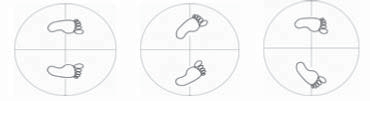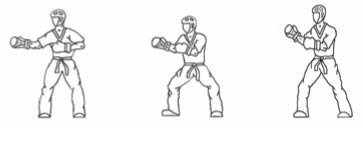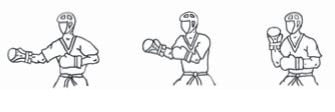Distinctive features of fight stance and movement of kickboxers in “points fighting” division
Фотографии:
ˑ:
M.V. Gerasimov, candidate, Honored master of sport. Moscow state academy of physical culture, Malakhovka, the Moscow region
Key words: point fighting, fight stance, movement, kickboxing.
Introduction. Kickboxing that is one of the most popular martial arts nowadays, is made of 7 divisions [5,6], that in their turn can be divided into ring (K-1, low kick, full contact) and tatami (kick light, light contact, kick forms, point fighting) disciplines. All the divisions, except for “kick forms”, presuppose a face-to-face combat with an opponent, differ by rigidity of single combat and approved fair kicks, but as for technique of single combat, all the divisions are absolutely the same, except for point fighting.
Point fighting is assumed one of the most popular divisions of kickboxing in the world. In Russia this division has become popular only a short time ago and our athletes are getting competitive on the European and international levels.
Proceeding from the analysis of the courseware and specialized literature on kickboxing, observations of the leading world-class athletes, based on the experience of representatives and trainers (J. Rizzi, I. Kirali, V.N. Kleschev, A.V. Kotov, A.G. Mitkevich) as well as personal experience of athlete of the national team of Russia, the lack of the courseware in this division has been revealed.
The purpose of the study was to allocate the distinctive features of kickboxers’ fight stance and movement and work practical guidelines on teaching technique in the division of point fighting.
Materials and methods. The technical range of kickboxing is presented in the literature sources based on the boxing hand technique and the karate leg technique [1,2,3,4], that proved inefficiency of kickboxers’ performance in point fighting on the international arena. But in the last 3-4 years the situation has changed thanks to leading international instructors invited to the national team of Russia, giving an impetus to improvement of the point fighting technique, considerably differing from other divisions of kickboxing.
The pedagogical observation of the strongest kickboxers of the world and Europe, made by means of video recording and within major competitions, resulted in the allocation of substantial differences in the fight stance and methods of movement of point fighting athletes from other kickboxing divisions.
Fight stance. An experienced athlete will immediately see its pros and cons by looking on an opponent’s fight stance. One should look at the position of three body parts such as feet, legs and hands for a full description of the fight stance.
Feet:
Variant 1: Feet standing sideways to an opponent for a more stable and safe position (Fig.1);
Variant 2: Feet turned slightly forward to an opponent for a faster attack (Fig. 2);
Variant 3: Front foot turned sideways or with toes slightly to an opponent, rear one turned with a heel to the opponent for a fast attack with a slipping leg and for moving back promptly in case of an opponent’s attack (Fig. 3.).

Fig. 1. Fig. 2. Fig.3.
Legs:
Variant 1: Legs are in a line turned sideways, at shoulder-width distance, knees are locked when moving. So athlete can be taller than his opponents, such a stance is especially popular among tall athletes, gaining the advantage over short opponents (Fig. 4).
Variant 2: Legs are in a line, at a bit more than shoulder-width distance, knees are slightly bent in this stance or sometimes strongly bent, this stance is most popular among short athletes (Fig. 5).
Variant 3: Legs are not in a line turned. Rear leg is behind the back with the toe in line with the heel of the front leg or a bit further. In such a stance knees are usually in a semiflexed position (Fig. 6).

Fig. 4. Fig. 5. Fig. 6.
Hands:
Variant 1: front hand is almost straight to an opponent’s stomach, giving control over the distance and leg attacks of an opponent, the second hand is lowered or pressed to breast ready to strike a punch (Fig. 7).
Variant 2: front hand is in a semiflexed position for a wide range of actions when moving (Fig. 8).
Variant 3: front hand is bent strongly at the elbow, the fist of the rear hand is under the elbow of the front hand for good defense and closed stance (Fig. 9).

Fig. 7. Fig. 8. Fig. 9.
Front hand is of principle value in all stances, it controls an opponent and provides for fast attack or counterattack. In all stances one should be ultimately relaxed but still ready to make a strong and precise punch. The fastest possible punch is impossible with clenched fists and strained shoulders resulting in hardly raised hands and strained muscles by the end of a fight. All body is to be completely relaxed. Only then one can attain an optimal state to do numerous fights in one day at a high speed.
Movement. When one moves well, he feels confident in a fight, but not as a target for an opponent. The movement in a fight is made mostly with legs an athlete uses to move on a tatami controlling the distance and choosing appropriate distance to attack or counterattack, but one should not forget about hands that do much work in keeping and feeling the distance.
Fast, efficient leg work is of vital importance in point fighting, since the fight itself is based on movements. Movement is used to move closer and back and keep a distance with an opponent. Athletes move to strike a kick or perform a fake and create an open place for a kick. They move back to avoid a kick and to counterattack efficiently to an opponent’s attack. They also move diagonally and sideways confusing an opponent.
Movement is to be first started from the simple step in place. Movement is made on front foot pads as its base. Knees act as supinators and are bent. Movement in a step can be compared with hitting a basketball ball on the floor, legs as well as ball can move with different speed and tempo, from smooth and slow to fast and abrupt. Proceeding from the observations of elite athletes, the frequently used movements are as follows:
1. Step. Athletes with a limited technical range move mainly up and down (in place) or back and forth, being constantly on a focus and an easy target for an opponent. If both of the fighters use this shuffle such a fight most frequently reminds an unarmed fencers' duel. Legs are moved in place (or “static’) mainly simultaneously and when moving back and forth – in series.
Side-to-side motions made to avoid a direct attack from an opponent are specific for an athlete engaged in point fighting.
Side shuffles can be uncomfortable for an opponent, for example, for the one moving in a straight line, for he needs to focus on the target to get ready to attack, which is getting extremely hard to do.
2. Skipping. Skips are fast and sudden for an opponent. Skip is to differ from movements in speed and severity. The skipping technique is varied. In a step successive leg movements are used, while in a skip a take-off is made simultaneously or by turns, depending on a fight stance. In lunge forward a take-off leg can be a rear one that starts moving forward by an impulse, followed by both legs lifted from the floor and shuffling, as if slipping across the floor in a set direction, here forward, land on the floor. Landing is made on a front leg, caught up by a rear leg or both legs simultaneously. Side skip is assumed by the majority as a more efficient movement than a step due to successive leg movements made in a step, so an opponent can see the movement of the first leg and react to this movement. Athlete makes minimum movements, specifically one, in a side skip. When putting a front leg to a side, in the right direction to an opponent, a rear leg is shuffled around and the body is relocated from the attack line, well-situated for his attack. When an opponent moves this way it is very hard to trace a start due to the lack of preconditions.
3. Lunge. Lunge is also a good method in shuffles, but its range is rather limited. It is directed mainly forward. If a lunge is made correctly, a rear leg stays in place and a front one moves slightly forward and immediately goes back, for self-defense, returning to a safe distance. Generally, the front leg movement is accompanied by simulation of a front hand kick, that same as the leg returns to a starting position to intimidate an opponent. Using a lunge one can test an opponent’s reaction: if he moves back or is trying to use some defense or counterattack actions, or has no reaction at all, which promotes a confident attack.
4. Running. This movement, that is usually applied to catch up with an opponent who is running away or is far, but one should be careful here due to a potential counterattack. Sometimes an athlete intentionally instigates his opponent to run, ready for counterattack. Seeing a running away athlete or rather flinching from combat is very common during the last seconds of the combat, that looks not vey fair, such actions are usually severely punished up to losing one point.
5. Slipping. Slipping is made on one leg. A front leg is raised up and bent in the knee which is the peak point, a rear leg is supportive. Right positioning of the stationary foot (slipping leg) is one of the primary goals in slipping. The heel of the stationary foot is to face the direction of the move. It makes for slipping faster and longer, but if the foot is reversed it will slow down the speed and the next leg kick will be not strong for the foot will prevent from shifting hips to the full. Athletes who are good at this technique can slip on one leg from 1 to 1.5 meters.
6. Jumping. The technique seldom used in fights. Only very experienced athletes use this element of movement that can score 2 or even 3 points but still there is a risk of taking a hit, since a combatant who jumped is in the air and a punch that failed to hit the target can result in an opponent’s fast counterattack and a lost point.
When watching fights of international point fighting masters one can see all sorts of combinations of the techniques of movement stipulated above. In an attack the most frequent combinations are as follows: walk forward and lunge, skip forward and lunge, walk forward and jump, lunge and slipping, skip forward and jump etc.
Legs do the main task in movement, but hands are also important, that are harmoniously introduced into movement to legs. Hands can help to keep a safe distance and to control an opponent. The front hand is to be well coordinated and help legs to move. In its’ turn, a rear hand is always ready to attack or counterattack.
Here are some basic movements:
Variant 1: Static. The front hand is static, the distance can be different either stretched or pressed. The opponent’s arm is always on a focus, controlling his actions when he moves. An outstretched arm is assumed more efficient in this technique. In such a position we can achieve the goal much faster, for the hand is already a bit closer to an opponent and it will be hard for him to see the intention movement, rather than see an attack to come from the hand pressed to the body, an experienced opponent will see the movement early enough to react. The punch from the pressed to chest position will take more time than the one made by a put out hand. The rear hand can be in any position, but the best if it covers the chest.
Variant 2: Lunges. Hand makes a contracted action as a punch and goes back immediately. The hand lunge can be combined with a leg movement or made separately, for example, at static leg movements hand can create a menace for an opponent, lunging forward and legs staying in place. The rear hand can be in any position, but the best if it covers the chest.
Variant 3: Playing. Here the front hand moves chaotically in front of an opponent, as if painting something but does it very fast. The hand moves easily to and fro, creating a nuisance for an opponent and an optimal situation for an attack for himself. The rear hand can be in any position, but the best if it covers the chest. If choosing this variant of movement one should feel every action and understand why he is doing it.
Variant 4: Clownish. These are movements that do nothing good. Hands can be over head, spread apart etc. This technique is usually used by athletes trying to instigate their opponent to do some actions. In most cases such a technique is useless since athlete forgets to defend and it is extremely hard to attack fast with the hand in such a position. When using this technique athlete himself often has a limited technical range and makes fun of himself. All technical actions should be proved and task-oriented.
Looking through the fights of world leaders one can see similarities in movement and shuffle, the similarities are especially notable among athletes from one team and school. Using the long-term observation of the leaders of international point fighting, we would like to consider movement technique in the leading schools:
In the Irish school of point fighting, steps and sub-steps prevail in movement. Keeping an opponent at a distance, the Irish are trying to make an attack with slow and small steps, but they sit on the rear leg, that in most cases is reversed with the heel up to make a faster counterattack. These small steps are also of different tempo, from slow, soporific sneaking up on an opponent to fast step, advancing slowly to an opponent. Hands generally remain static. The notable fighters include: Robbie McMenamy, Jason Doyle, Marc McDermot.
The Italians are creative in their movements. They have more lunges and skips. Moving fast on a tatami they use abrupt lunges and skips, both linear and side, promoting a more effective attack. They also use well the jumping movement technique, their feet move very hard, ready to make an impulse to a move any time. Hands are moved from a semiflexed position making dead-sets or moving in a playing manner. The notable fighters include: Gregorio Di Leo “Grillo”, Gloria De Bei, Adriano Passaro.
Norwegian athletes are very predictable in their movements, you can take any Norwegian athlete and he will move same as the rest. Movement is made in step in place. In this movement lunges and skips are mainly dominating, as opposed to the Italians, they work one by one directly, but still their movements are so abrupt and fast they can promote an ideal situation for an attack. The leading hand in the athletes from this national team lunges forward strongly along with a leg lunge. The notable fighters include: Eirin Dale, Ida Abrahamsen, Morten Spissoy.
Athletes from the Hungarian national team are very diverse in their stances and movements, rate of movement but still have something in common. It is their rhythm of movement, most of athletes use monotonous rhythm, when moving in a step in place, but as soon as they use some of fake movements, the rhythm changes right away from slow to fast and vice versa. The notable fighters include: Zsolt Moradi, Krisztian Jaroszkievicz, Laszlo Gombos.
Conclusion. The results of the natural educational experiment approve the appropriateness of introduction into the program of kickboxers’ long-term training of the studies of distinctive features of fight stance and movement of athletes of the point fighting division, providing for significant extension of kickboxers’ technical capacities within a sports contest.
References
- Gagonin, S.G. Sports competitive martial arts: from ancient wushu and bujutsu to professional kickboxing / S.G. Gagonin – St.Petersburg: SPbSAPC named after P.F. Lesgaft, 1997. – 352 P. (In Russian)
- Golovikhin, E.V. Curriculum for educational institutions specialized in kickboxing / E.V. Golovikhin, A.G. Mitkevich. – Moscow: 2009. – 145 P. (In Russian)
- Ivanov, A.L. Kickboxing – Kiev: Perun, 1994. – 312 P. (In Russian)
- Kleschev, V.N. Kickboxing / V.N. Kleschev. – Moscow: Akademicheskiy proekt, 2006. – 288 P. (In Russian)
- Ashley, S. Kickboxing / S. Ashley. – England: Lumina Press, 2011. – 139 P.
- Falsoni, E. Kickboxing the phenomenology of a sport / E. Falsoni, A. Micheli. – Milan: miolagrafiche s.r.l. 2011. – 205 P.
Author’s contacts: gerasimov.mik@gmail.com


